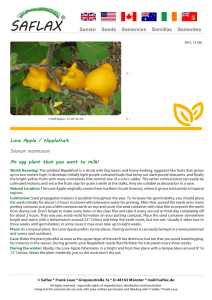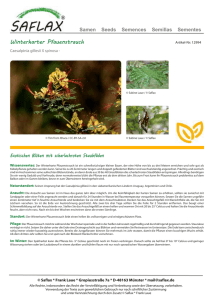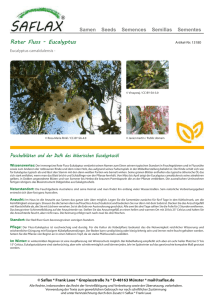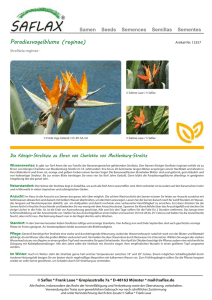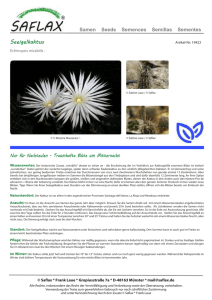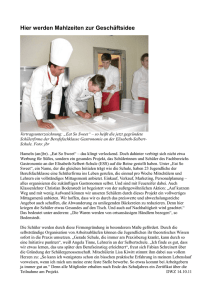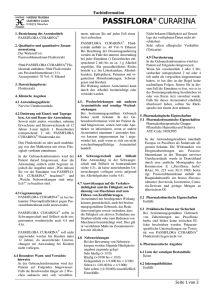Samen Seeds Semences Semillas Sementes
Werbung
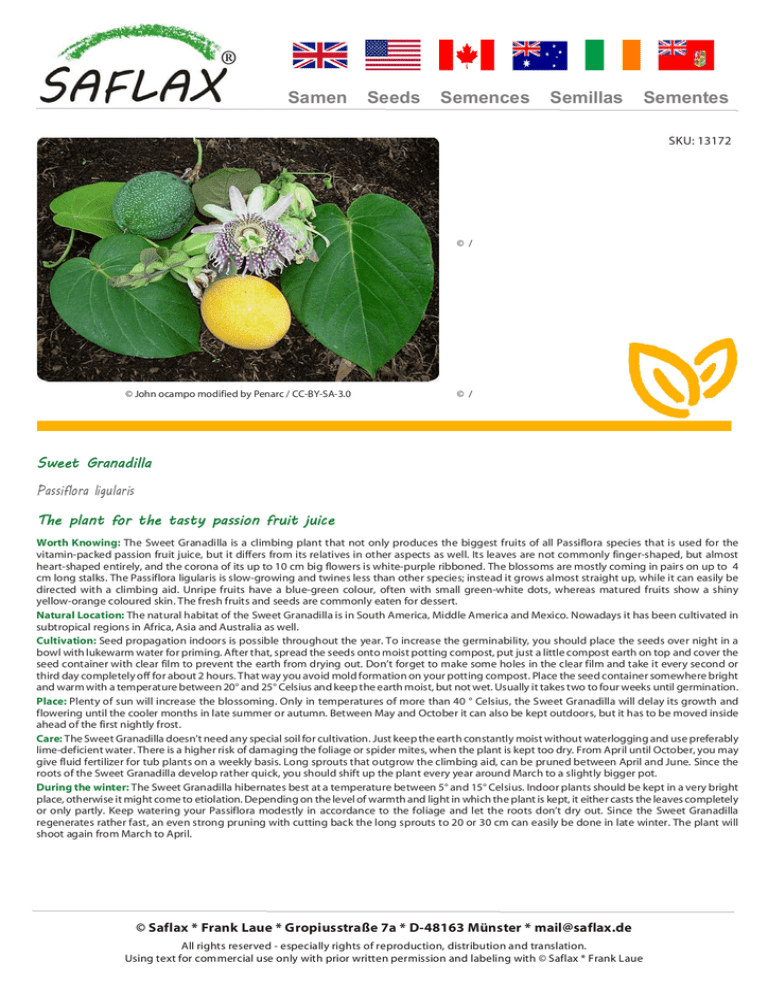
® Samen Seeds Semences Semillas Sementes SKU: 13172 © / © John ocampo modified by Penarc / CC-BY-SA-3.0 © / Sweet Granadilla Passiflora ligularis The plant for the tasty passion fruit juice Worth Knowing: The Sweet Granadilla is a climbing plant that not only produces the biggest fruits of all Passiflora species that is used for the vitamin-packed passion fruit juice, but it differs from its relatives in other aspects as well. Its leaves are not commonly finger-shaped, but almost heart-shaped entirely, and the corona of its up to 10 cm big flowers is white-purple ribboned. The blossoms are mostly coming in pairs on up to 4 cm long stalks. The Passiflora ligularis is slow-growing and twines less than other species; instead it grows almost straight up, while it can easily be directed with a climbing aid. Unripe fruits have a blue-green colour, often with small green-white dots, whereas matured fruits show a shiny yellow-orange coloured skin. The fresh fruits and seeds are commonly eaten for dessert. Natural Location: The natural habitat of the Sweet Granadilla is in South America, Middle America and Mexico. Nowadays it has been cultivated in subtropical regions in Africa, Asia and Australia as well. Cultivation: Seed propagation indoors is possible throughout the year. To increase the germinability, you should place the seeds over night in a bowl with lukewarm water for priming. After that, spread the seeds onto moist potting compost, put just a little compost earth on top and cover the seed container with clear film to prevent the earth from drying out. Don’t forget to make some holes in the clear film and take it every second or third day completely off for about 2 hours. That way you avoid mold formation on your potting compost. Place the seed container somewhere bright and warm with a temperature between 20° and 25° Celsius and keep the earth moist, but not wet. Usually it takes two to four weeks until germination. Place: Plenty of sun will increase the blossoming. Only in temperatures of more than 40 ° Celsius, the Sweet Granadilla will delay its growth and flowering until the cooler months in late summer or autumn. Between May and October it can also be kept outdoors, but it has to be moved inside ahead of the first nightly frost. Care: The Sweet Granadilla doesn’t need any special soil for cultivation. Just keep the earth constantly moist without waterlogging and use preferably lime-deficient water. There is a higher risk of damaging the foliage or spider mites, when the plant is kept too dry. From April until October, you may give fluid fertilizer for tub plants on a weekly basis. Long sprouts that outgrow the climbing aid, can be pruned between April and June. Since the roots of the Sweet Granadilla develop rather quick, you should shift up the plant every year around March to a slightly bigger pot. During the winter: The Sweet Granadilla hibernates best at a temperature between 5° and 15° Celsius. Indoor plants should be kept in a very bright place, otherwise it might come to etiolation. Depending on the level of warmth and light in which the plant is kept, it either casts the leaves completely or only partly. Keep watering your Passiflora modestly in accordance to the foliage and let the roots don’t dry out. Since the Sweet Granadilla regenerates rather fast, an even strong pruning with cutting back the long sprouts to 20 or 30 cm can easily be done in late winter. The plant will shoot again from March to April. © Saflax * Frank Laue * Gropiusstraße 7a * D-48163 Münster * [email protected] All rights reserved - especially rights of reproduction, distribution and translation. Using text for commercial use only with prior written permission and labeling with © Saflax * Frank Laue ® Samen Seeds Semences Semillas Sementes Artikel-Nr: 13172 © / © John ocampo modified by Penarc / CC-BY-SA-3.0 © / Süße Granadilla Passiflora ligularis Die Pflanze für den leckeren Maracuja-Saft Wissenswertes: Die als Kletterpflanze wachsende Süße Grenadille bildet nicht nur die größten Früchte aller Passionsblumen für den vitaminreichen Maracuja-Saft aus, sondern unterscheidet sich auch sonst von ihren Verwandten. Ihre Blätter sind nicht wie sonst finger-, sondern fast herzförmig und ganzrandig. Der Strahlenkranz Ihrer bis zu 10 Zentimeter großen Blüten ist weiß-lila bebändert. Die Blüten stehen häufig in Paaren an bis zu vier Zentimeter langen Stielen. Die Passiflora ligularis wächst langsam und schlingt weniger stark als ihre Verwandten, sondern wächst fast gerade nach oben. Sie lässt sich aber gut an Klettergerüsten emporlenken. Unreife Früchte sind blaugrün und häufig mit kleinen grünlichweißen Punkten bedeckt, reife Früchte haben eine glänzend orangegelbe Schale. Die Früchte werden mit den Samen gerne frisch als Dessert gegessen. Naturstandort: Das natürliche Verbreitungsgebiet liegt in Südamerika, Mittelamerika und Mexiko. Mittlerweile wird sie auch in den subtropischen Gebieten Afrikas, Asiens und Australiens kultiviert. Anzucht: Im Haus ist die Anzucht aus Samen das ganze Jahr über möglich. Um die Keimfähigkeit der Samen zu erhöhen, sollten sie zunächst überNacht in Wasser bei Raumtemperatur anquellen. Streuen Sie den Samen dann auf feuchte Anzuchterde und bedecken Sie sie nur dünn mit dem Anzuchtsubstrat. Spannen Sie Klarsichtfolie über das Anzuchtgefäß und stechen Sie einige Löcher in die Folie. So ist die Erde vor Austrocknung geschützt. Alle zwei bis drei Tage sollten Sie die Folie für 2 Stunden entfernen. Das beugt einer Schimmelbildung auf der Anzuchterde vor. Stellen Sie das Anzuchtgefäß an einen hellen und warmen Ort mit 20 bis 25° Celsius und halten Sie die Anzuchterde feucht, aber nicht nass. Bis zur Keimung dauert es dann erfahrungsgemäß zwei bis vier Wochen. Standort: Viel Sonne fördert eine reiche Blüte. Bei deutlich über 40 ° Celsius stellt die Passionsblume allerdings ihre Wachstums und Blütenentwicklung ein und verschiebt die Blüte auf die kühleren Monate im Spätsommer oder Herbst. Von Mai bis Oktober ist auch ein Platz im Freien möglich. Vor den ersten Nachtfrösten muss sie aber heringeholt werden. Pflege: Die Süsse Granadilla ist hinsichtlich der Bodenqualität genügsam. Halten Sie die Erde stets feucht, aber vermeiden Sie Staunässe und allzu kalkhaltiges Gießwasser. Starke Trockenheit kann zu Blattverlusten und Befall durch Spinnmilben führen. Den Nährstoffbedarf decken Sie am besten von April bis Oktober wöchentlich mit flüssigem Kübelpflanzendünger. Triebe, die zu lang werden und an der Kletterhilfe keinen Platz mehr finden, können von April bis Juni sofort eingekürzt werden. Da die Passionsblume den Topf rasch durchwurzelt, sollten Sie sie jedes Jahr im März im März in ein leicht größeres Gefäß umtopfen. Im Winter: Am besten überwintert die Süße Granadilla hell bei 5 bis 15° Celsius. Überwintert die Süße Granadilla als Zimmerpflanze, sollten Sie einen sehr hellen Standort wählen, da die Pflanze sonst vergeilt. Je nach Wärme und Licht des Winterplatzes bleibt ein Teil des Laubs erhalten oder wird vollständig abgeworfen. Wässern Sie weiter leicht in Abhängigkeit der verbleibenden Blattmasse soviel, dass der Wurzelballen nicht völlig austrocknet.. Ein kräftiger Rückschnit auf eine Trieblänge von 20-30 cm im Spätwinter ist problemlos möglich, da sich Passionsblumen rasch regenerieren. Der Neuaustrieb erfolgt dann wieder ab März bis April. © Saflax * Frank Laue * Gropiusstraße 7a * D-48163 Münster * [email protected] Alle Rechte, insbesondere das Recht der Vervielfältigung und Verbreitung sowie der Übersetzung, vorbehalten. Verwendung der Texte zum gewerblichen Gebrauch nur nach schriftlicher Zustimmung und unter Kennzeichnung durch den Zusatz © Saflax * Frank Laue
